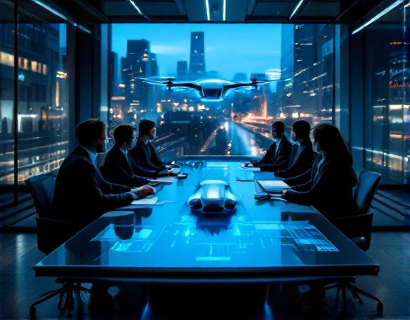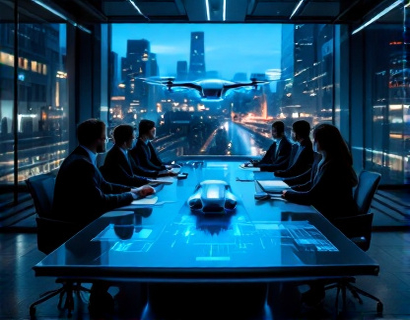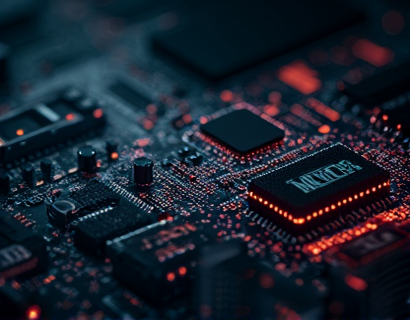AI-Powered Solutions for Aeronautics Business Optimization
The aeronautics industry, a cornerstone of global transportation and commerce, faces unique challenges that demand innovative solutions. As the sector continues to evolve, the integration of Artificial Intelligence (AI) has emerged as a pivotal strategy for businesses aiming to optimize operations, enhance decision-making, and drive sustainable growth. This article delves into the transformative potential of AI-powered solutions in the aeronautics sector, exploring how these advanced technologies can streamline processes, boost efficiency, and provide tailored insights to address the industry's complex needs.
Understanding the Challenges in Aeronautics
The aeronautics industry is characterized by stringent regulatory requirements, high operational costs, and the need for continuous innovation. Businesses in this sector must navigate a complex landscape of safety standards, environmental regulations, and technological advancements. Traditional methods of managing these challenges often prove inadequate, leading to inefficiencies and missed opportunities. AI offers a robust framework to tackle these issues head-on, providing tools and insights that can significantly enhance operational performance and strategic decision-making.
Streamlining Operations with AI
One of the most immediate benefits of AI in aeronautics is the streamlining of operations. AI-driven systems can automate routine tasks, from scheduling and maintenance to supply chain management. For instance, predictive maintenance algorithms can analyze data from sensors and historical records to forecast equipment failures before they occur, reducing downtime and maintenance costs. This proactive approach not only enhances reliability but also optimizes resource allocation.
Flight planning and route optimization are other areas where AI excels. By analyzing real-time data on weather conditions, air traffic, and aircraft performance, AI can suggest the most efficient flight paths, minimizing fuel consumption and travel time. This not only reduces operational costs but also lowers the environmental impact of flights, aligning with the industry's sustainability goals.
Enhancing Decision-Making with Data Analytics
Data-driven decision-making is crucial in the aeronautics industry, where the stakes are high and the consequences of errors can be severe. AI-powered analytics tools can process vast amounts of data from various sources, including flight logs, maintenance records, and market trends, to provide actionable insights. These insights can inform strategic decisions on everything from fleet management to customer service improvements.
For example, AI can analyze passenger behavior and preferences to optimize seating arrangements and in-flight services, enhancing customer satisfaction and loyalty. Similarly, by monitoring market trends and competitor activities, airlines can adjust their pricing strategies and service offerings to stay competitive.
Tailored Insights for Unique Challenges
Each aeronautics business faces unique challenges based on its size, focus, and operational scope. AI solutions can be tailored to address these specific needs, providing customized tools and analytics. For regional carriers, AI can optimize route networks to maximize coverage and efficiency, while for major carriers, it can manage complex global operations with precision. For manufacturers of aerospace components, AI can optimize production lines and quality control processes, ensuring high standards and reducing waste.
Moreover, AI can help in compliance and risk management. By continuously monitoring regulatory changes and operational data, AI systems can alert businesses to potential compliance issues and suggest corrective actions. This proactive approach helps avoid penalties and reputational damage, ensuring smooth operations.
Improving Safety and Security
Safety and security are paramount in the aeronautics industry. AI technologies can significantly enhance these aspects by providing advanced monitoring and threat detection capabilities. For instance, AI-powered surveillance systems can analyze video feeds in real-time to detect unusual activities or potential security threats at airports and on aircraft. Similarly, AI can monitor flight data to identify patterns that may indicate mechanical issues or other safety concerns, enabling timely interventions.
In addition, AI can play a crucial role in cybersecurity, protecting sensitive data and systems from cyber threats. The aeronautics industry is increasingly reliant on digital technologies, making it a prime target for cyberattacks. AI-driven security solutions can detect and respond to threats more rapidly and effectively than traditional methods, ensuring the integrity and safety of operations.
Driving Innovation through AI
Beyond optimizing existing processes, AI can drive innovation in the aeronautics sector. By analyzing vast datasets, AI can identify new opportunities and inspire novel solutions. For example, AI can assist in the design of more efficient aircraft by simulating various configurations and materials, leading to breakthroughs in aerodynamics and fuel efficiency. It can also support the development of autonomous flight systems, paving the way for the next generation of aviation technology.
Furthermore, AI can facilitate collaboration and knowledge sharing among industry stakeholders. Platforms powered by AI can connect experts, researchers, and businesses, fostering a community of innovation and continuous improvement. This collaborative approach can accelerate the adoption of new technologies and practices, keeping the industry at the forefront of global advancements.
Case Studies and Real-World Applications
Several aeronautics businesses have already begun to leverage AI to transform their operations. For instance, a major airline implemented an AI-driven predictive maintenance system that reduced unscheduled maintenance by 20% and decreased maintenance costs by 15%. Another regional carrier used AI to optimize its route network, resulting in a 10% reduction in fuel consumption and a corresponding decrease in emissions.
A leading aerospace manufacturer utilized AI in its design process, reducing the time to market for new aircraft models by 30%. These case studies demonstrate the tangible benefits of AI in the aeronautics industry, from cost savings and efficiency gains to environmental benefits and innovation.
Challenges and Considerations
While the potential of AI in aeronautics is vast, there are challenges and considerations that businesses must address. One key issue is the integration of AI systems with existing infrastructure. This requires careful planning and investment to ensure compatibility and seamless operation. Additionally, the quality and availability of data are critical for AI's effectiveness. High-quality, relevant data is essential for training AI models and ensuring accurate insights.
Another consideration is the need for skilled personnel to manage and interpret AI systems. As AI becomes more integral to operations, there is a growing demand for professionals with expertise in AI and data science. Businesses must invest in training and development to build a capable workforce.
Future Trends and Opportunities
The future of AI in aeronautics is promising, with several emerging trends and opportunities on the horizon. One such trend is the integration of AI with the Internet of Things (IoT) to create smart, interconnected systems. This can lead to more responsive and efficient operations, from real-time monitoring of aircraft components to intelligent airport management systems.
Another area of growth is the use of AI in sustainability efforts. As the industry faces increasing pressure to reduce its environmental impact, AI can play a crucial role in optimizing fuel usage, reducing emissions, and developing more sustainable materials and processes. Additionally, AI can support the transition to electric and hybrid aircraft by optimizing battery management and charging infrastructure.
Lastly, the rise of autonomous and unmanned aerial vehicles (UAVs) presents new opportunities for AI applications. AI can enhance the safety and efficiency of drone operations, from delivery services to surveillance and inspection tasks. As regulations evolve, the potential for AI-driven UAVs to transform various sectors, including logistics and infrastructure monitoring, will become more apparent.
Conclusion
AI-powered solutions offer a transformative path for aeronautics businesses to optimize operations, enhance decision-making, and drive innovation. By addressing the unique challenges of the industry with advanced technologies, businesses can achieve significant improvements in efficiency, safety, and sustainability. As the aeronautics sector continues to evolve, embracing AI will be essential for staying competitive and leading the way into a new era of aviation.










































